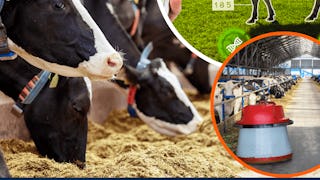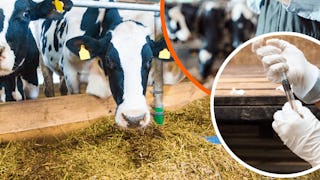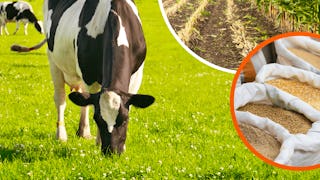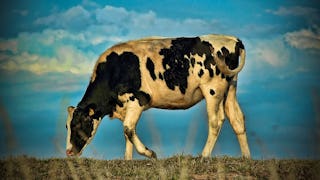Mit dem weltweit ersten MOOOOO-C erhalten Sie ein breites und umfassendes Verständnis aller Aspekte des Milchwirtschaftsmanagements wie Genetik, Ernährung, Reproduktion, Tiergesundheit, Betriebswirtschaft und Nachhaltigkeit von Milchproduktionssystemen. Hier ist für jeden etwas dabei, egal ob Sie nur nach den Grundlagen suchen oder bereits jahrelange Erfahrung in der Milchwirtschaft haben. Dieser Kurs dauert acht Wochen. Jede Woche besteht aus vier bis neun Videovorlesungen, zusätzlichem Lesematerial und einem Quiz mit Multiple-Choice-Fragen. Die geschätzte Lernzeit liegt zwischen drei und fünf Stunden pro Woche. Lernende haben die Möglichkeit, ein Kurszertifikat für 49,00 USD zu erwerben. Das Zertifikat kann jederzeit erworben werden, aber Sie müssen sich vor der Teilnahme an den Quizfragen des Kurses ausweisen, um berechtigt zu sein. Für diejenigen, die sich die Gebühr für das Zertifikat nicht leisten können, gibt es finanzielle Unterstützung durch Coursera. Warum ist eine effiziente und nachhaltige Milchproduktion so wichtig?



Molkereiproduktion und Management



Dozenten: Alexander N. Hristov
62.125 bereits angemeldet
Bei  enthalten
enthalten
(1,470 Bewertungen)
Kompetenzen, die Sie erwerben
- Kategorie: Führung und Management
Wichtige Details

Zu Ihrem LinkedIn-Profil hinzufügen
8 Aufgaben
Erfahren Sie, wie Mitarbeiter führender Unternehmen gefragte Kompetenzen erwerben.


Erwerben Sie ein Karrierezertifikat.
Fügen Sie diese Qualifikation zur Ihrem LinkedIn-Profil oder Ihrem Lebenslauf hinzu.
Teilen Sie es in den sozialen Medien und in Ihrer Leistungsbeurteilung.

In diesem Kurs gibt es 8 Module
Im Modul Milchviehgenetik erfahren Sie mehr über die verschiedenen Milchviehrassen, ihre Beliebtheit und wie sich die Leistung von einer Rasse zur nächsten unterscheidet. Wir werden uns mit den vielen verschiedenen Merkmalen befassen, die von Landwirten und Züchtern bei der genetischen Selektion bewertet werden, und damit, wie wir Daten zur Durchführung genetischer Bewertungen sammeln. Um den Selektionsprozess zu vereinfachen, werden wir Selektionsindizes betrachten. Sie werden erfahren, wie sich das Milchvieh in den letzten fünfzig Jahren verändert hat und welche Faktoren die Geschwindigkeit des genetischen Fortschritts beeinflussen. Schließlich werden Sie etwas über die Technologien erfahren, die dazu beigetragen haben, den genetischen Fortschritt bei Milchkühen zu beschleunigen, wie z.B. die künstliche Besamung und genomische Tests. Diejenigen unter Ihnen, die sich stärker in die Diskussionen einbringen möchten und daran interessiert sind, die Anforderungen für das Kurszertifikat zu erfüllen, können an den Diskussionsforen teilnehmen und das wöchentliche Quiz absolvieren. Wir wünschen Ihnen viel Spaß beim Lernen über die Genetik der Milchkuh!
Das ist alles enthalten
6 Videos41 Lektüren1 Aufgabe
In dieser Woche erfahren Sie, was Futterpflanzen sind, warum sie wichtig sind und welche vielfältigen Aufgaben sie auf dem Milchviehbetrieb erfüllen. Wir werden auch einige der grundlegenden Managementüberlegungen besprechen, die mit der Einrichtung, Produktion und Ernte dieser Kulturen verbunden sind. Der erste Vortrag konzentriert sich auf die vielfältigen Aufgaben, die Futterpflanzen im Betrieb erfüllen, und auf die Überlegungen, die notwendig sind, um ein effektives System für die Futtermittelproduktion zu entwickeln. In der zweiten Vorlesung werden wir einige gängige mehrjährige Futterpflanzen und deren Management besprechen. Dazu gehören Luzerne, Luzerne-Gras-Mischungen und Gräser. In der dritten Vorlesung werden wir die einjährigen Futterpflanzen besprechen, die üblicherweise in Milchviehbetrieben verwendet werden: Mais, Sorghum und Kleingetreide. Sie werden lernen, wie man Weiden in Milchproduktionssystemen nutzen kann. In der vierten Vorlesung geht es um die Weidehaltung und das Weidemanagement, einschließlich der Herausforderungen von Weidesystemen, der Entwicklung des Weidemanagements und des richtigen Weidemanagements für eine optimale Futterversorgung und Produktivität der Tiere. Der fünfte Vortrag befasst sich mit der Ernährung von Weideherden, einschließlich des Nährstoffgehalts der Weide im Verhältnis zum Nährstoffbedarf laktierender Milchkühe und strategischer Ergänzungsstrategien für eine optimale Tiergesundheit und Milchproduktion. Diejenigen von Ihnen, die sich stärker in die Diskussionen einbringen möchten und daran interessiert sind, die Anforderungen für das Kurszertifikat zu erfüllen, können sich an den Diskussionsforen beteiligen und das wöchentliche Quiz absolvieren. Viel Spaß mit dem Material dieser Woche und mit dem gesamten Kurs!
Das ist alles enthalten
5 Videos43 Lektüren1 Aufgabe
In dieser Woche erfahren Sie mehr über Futtermittel, die üblicherweise an Milchkühe verfüttert werden, und über die Futtermittelverarbeitung. Wir werden zunächst die Fütterungseigenschaften von Futtermitteln wie Maissilage, Luzerneheulage, Gras- und Kleingetreidesilagen besprechen, dann zu Kraftfutter übergehen, das in einer Milchviehration Energie oder Eiweiß liefert, und zum Schluss Futterzusätze besprechen. Außerdem erfahren Sie etwas über die wichtigsten Faktoren bei der Herstellung von hochwertigem Heu und Silage für Milchkühe. In der letzten Vorlesung dieser Woche lernen Sie Verarbeitungsmethoden zur Erhöhung des Nährwerts von Futtermitteln, die Bedeutung der Partikelgröße und der effektiven Ballaststoffe in Milchviehrationen sowie die gängigsten Verarbeitungsmethoden für Getreidekörner und Ölsaaten kennen. Zum Schluss werden wir besprechen, wie Sie Berichte über Futtermittelanalysen lesen und verstehen können. Diejenigen unter Ihnen, die sich stärker in die Diskussionen einbringen möchten und daran interessiert sind, die Anforderungen für das Kurszertifikat zu erfüllen, können an den Diskussionsforen teilnehmen und das wöchentliche Quiz absolvieren. Viel Spaß mit dem Material dieser Woche und mit dem gesamten Kurs!
Das ist alles enthalten
6 Videos40 Lektüren1 Aufgabe
In dieser Woche erhalten Sie eine Einführung in die Grundsätze der Tierernährung, die grundlegenden Nährstoffe und ihren Stoffwechsel, die Quellen für diese Nährstoffe in der Milchviehfütterung, die Anatomie des Verdauungstrakts eines Wiederkäuers, die wunderbare Welt der Pansenmikroben und die wichtigsten Endprodukte der Pansenfermentation. Außerdem lernen Sie etwas über den Energie- und Eiweißstoffwechsel und die Ernährung sowie den Nährstoffbedarf und dessen Bedeutung für die Fütterung von Milchkühen. Im letzten Abschnitt von Woche 4 besprechen wir den Lebenszyklus einer Milchkuh, die Laktationskurve, Gruppierungsstrategien, die Grundlagen der Futterzusammenstellung, typische Energie- und Proteinquellen in der Milchviehfütterung, gehen auf die Mineralstoff- und Vitaminernährung ein, fassen die Ernährungsempfehlungen für die verschiedenen Phasen der Laktation zusammen und erläutern Techniken der Futterzubereitung. Diejenigen unter Ihnen, die sich stärker in die Diskussionen einbringen möchten und daran interessiert sind, die Anforderungen für das Kurszertifikat zu erfüllen, können an den Diskussionsforen teilnehmen und das wöchentliche Quiz absolvieren. Viel Spaß mit dem Material dieser Woche und mit dem gesamten Kurs!
Das ist alles enthalten
6 Videos40 Lektüren1 Aufgabe
Die Gesundheit, das Wachstum und die Produktivität von Kälbern hängen stark von der Ernährung und den Managementpraktiken ab. Jedes Färsenkalb, das in einem Milchviehbetrieb geboren wird, stellt eine Chance dar, die Herdengröße zu erhalten oder zu erhöhen, die Herde genetisch zu verbessern oder die wirtschaftlichen Erträge des Betriebs zu steigern. Die Ziele der Aufzucht des neugeborenen Kalbes bis zum Absetzalter sind die Optimierung des Wachstums und die Minimierung von Gesundheitsproblemen. In diesem Video werden wir die Entwicklung des Verdauungssystems des Kalbes besprechen und erfahren, wie wichtig Kolostrum für das Immunsystem ist und welche Nährstoffe das Kalb braucht, um gesund zu sein und gut zu wachsen. Wir besprechen die kritischen Wachstumsphasen der Milchfärse, die Bedeutung guter Einrichtungen und die Bedeutung der Ernährung für eine gesunde, gut gewachsene Färse, die bereit ist, gedeckt zu werden und ihr erstes Kalb zur Welt zu bringen. Das richtige Management und die richtige Ernährung der Milchkuh, die in die Laktation übergeht, sind sehr wichtig, um ein gesundes Kalb, eine höhere Reproduktionsleistung und eine optimale Milchproduktion in der folgenden Laktation zu erhalten. Wir werden lernen, wie dies durch eine ausgewogene Fütterung, guten Kuhkomfort und eine gute Körperkondition der Kuh vor und nach dem Kalben erreicht werden kann. Es gibt viele Fütterungsstrategien, die für die Fütterung trockener Kühe geeignet sind. Das Ziel sollte jedoch immer sein, qualitativ hochwertige Futterquellen, eine konstante Verfügbarkeit von Futter, einen angemessenen Liegeplatz und eine komfortable Umgebung zu bieten. Wir werden erörtern, wie die trockene Kuh vor dem Kalben am besten versorgt und gefüttert werden kann, damit sie mit einem gesunden Kalb in die Laktation übergehen und hochwertige Milch produzieren kann. Diejenigen unter Ihnen, die sich stärker in die Diskussionen einbringen möchten und daran interessiert sind, die Anforderungen für das Kurszertifikat zu erfüllen, können an den Diskussionsforen teilnehmen und das wöchentliche Quiz absolvieren. Viel Spaß mit dem Material dieser Woche und mit dem gesamten Kurs!
Das ist alles enthalten
7 Videos50 Lektüren1 Aufgabe
In dieser Woche lernen Sie die grundlegenden Konzepte im Zusammenhang mit der Fortpflanzung in Milchviehbetrieben kennen. Wir beginnen mit einer Diskussion über den Lebenszyklus der Milchkuh und darüber, wie man eine Färse angemessen auf ihr erstes Kalben vorbereitet. Als nächstes werden wir die grundlegende Anatomie und Funktion des männlichen und weiblichen Fortpflanzungstrakts besprechen. Anschließend erhalten Sie einen Überblick über den Brunstzyklus von Rindern und die wichtigsten Hormone und Eierstockstrukturen, die den Zyklus steuern. Im Anschluss daran werden wir die Faktoren erörtern, die die Ausprägung der Brunst bei Milchkühen steuern, und wie Sie die Brunst besser erkennen können. Wir werden darauf hinweisen, wie wichtig es ist, den Zeitpunkt des Eisprungs und der Besamung so zu wählen, dass die Empfängnisrate maximiert wird, und wir werden einige der Faktoren erörtern, die die Empfängnisrate verringern. Dies wird durch eine Diskussion der wichtigsten Reproduktionskennzahl, der Trächtigkeitsrate, veranschaulicht. Die Zuschauer werden Strategien zur Steigerung der Trächtigkeitsrate kennenlernen und die Methoden zur Erkennung von Trächtigkeit besser verstehen, ebenso wie die kritische Notwendigkeit einer frühzeitigen und genauen Erkennung von Trächtigkeit, um die Trächtigkeitsrate in den Betrieben zu maximieren. Diejenigen unter Ihnen, die sich stärker in die Diskussionen einbringen möchten und daran interessiert sind, die Anforderungen für das Kurszertifikat zu erfüllen, können an den Diskussionsforen teilnehmen und das wöchentliche Quiz absolvieren. Viel Spaß mit dem Material dieser Woche und mit dem gesamten Kurs!
Das ist alles enthalten
6 Videos39 Lektüren1 Aufgabe
In Woche 7 dieses Kurses lernen Sie etwas über Krankheiten bei Milchkühen und Kälbern sowie über Managementpraktiken zur Diagnose und Prävention. Unsere Diskussionen werden von der Einführung von Konzepten zur Krankheitsvorbeugung über Biosicherheit und evolutionäre Veränderungen bis hin zu Gesundheitsprogrammen für die Milchviehherde gehen. Die nächsten drei Diskussionen konzentrieren sich auf Krankheiten bei der kalbenden Kuh, dem Kalb und der laktierenden Kuh. Diese Lektionen vermitteln Hintergrundinformationen und praktische Fähigkeiten zur frühzeitigen Erkennung von Krankheitsproblemen, um die negativen Folgen für die Gesundheit und Leistung der Tiere zu minimieren. Die letzten beiden Diskussionen konzentrieren sich auf die Behandlung und Vorbeugung von Krankheiten und behandeln wichtige konzeptionelle Ansätze, da die spezifischen Mechanismen für die Behandlung und Vorbeugung von den gesetzlichen Bestimmungen in einem bestimmten Land abhängen. Wir werden uns mit dem kontroversen Thema des Antibiotikaeinsatzes bei der Behandlung von Kühen befassen, da dies ein wichtiges Anliegen für die Lebensmittelproduktion ist, aber auch Teil einer guten Tierpflege und der Gewährleistung des Tierschutzes. Präventive Praktiken wie Impfstrategien und Parasitenkontrolle werden in einem konzeptionellen Ansatz zusammengefasst, der auf unterschiedliche Situationen in den Betrieben angewendet werden kann. Abschließend werden wir die Bedeutung einer guten Ernährung hervorheben und so die Informationen aus anderen Kursmodulen mit der Einführung angemessener Managementpraktiken für die Milchviehhaltung verknüpfen, um eine gute Versorgung der Kühe sicherzustellen und Krankheitsrisiken zu minimieren. Diejenigen von Ihnen, die sich stärker an den Diskussionen beteiligen möchten und daran interessiert sind, die Anforderungen für das Kurszertifikat zu erfüllen, können sich an den Diskussionsforen beteiligen und das wöchentliche Quiz absolvieren. Viel Spaß mit dem Material dieser Woche und mit dem gesamten Kurs!
Das ist alles enthalten
13 Videos81 Lektüren1 Aufgabe
In Woche 8 des Kurses lernen Sie die Grundlagen des Managements von Milchviehbetrieben kennen und identifizieren einige wichtige Aspekte der Betriebswirtschaft, die sich auf die Produktivität und Rentabilität des Betriebs auswirken. Von der Ernte über die Kühe bis hin zum Geld - der Milchviehbetrieb ist ein wirtschaftlicher Motor, der sich positiv auf die lokalen Gemeinschaften auswirkt. Der zweite Teil dieser Serie geht über die lokalen Auswirkungen der Milchwirtschaft hinaus und bietet einen globalen Überblick über die Milchmärkte in aller Welt. Von der Preisvolatilität bis zum saisonalen Milchangebot - der Weltmarkt für Milchprodukte ist komplex. In den letzten Vorlesungen dieses Kurses werden wir die Auswirkungen der Milchproduktion auf die Umwelt und Strategien zur Verringerung der Stickstoff-, Phosphor- und Treibhausgasemissionen von Milchbetrieben diskutieren. Diejenigen von Ihnen, die sich stärker in die Diskussionen einbringen möchten und daran interessiert sind, die Anforderungen für das Kurszertifikat zu erfüllen, können an den Diskussionsforen teilnehmen und das wöchentliche Quiz absolvieren. Viel Spaß mit dem Material dieser Woche und mit dem gesamten Kurs!
Das ist alles enthalten
7 Videos51 Lektüren1 Aufgabe
Dozenten



Mehr von Tiergesundheit entdecken


University of Illinois Urbana-Champaign


University of Illinois Urbana-Champaign


University of Illinois Urbana-Champaign


University of Illinois Urbana-Champaign
Warum entscheiden sich Menschen für Coursera für ihre Karriere?




Bewertungen von Lernenden
1.470 Bewertungen
- 5 stars
87,21 %
- 4 stars
11,29 %
- 3 stars
0,95 %
- 2 stars
0,06 %
- 1 star
0,47 %
Zeigt 3 von 1470 an
Geprüft am 24. Sep. 2021
Highly practical oriented and you can always download the pdf carrying the relevant teaching material which is so helpful. Very nice course, not easy, not har but just right. Valuable.
Geprüft am 5. Aug. 2020
I would like to thank all the professors and mentors for guiding me about different aspects of dairy production and management with applicable examples (wherever required ) in depth.
Geprüft am 1. Aug. 2020
its a very comprehensive module to educate the new comers in all the aspects for Dairy Framing. I found it very easy to learn, understand and relate to the topics very easily.

Neue Karrieremöglichkeiten mit Coursera Plus
Unbegrenzter Zugang zu 10,000+ Weltklasse-Kursen, praktischen Projekten und berufsqualifizierenden Zertifikatsprogrammen - alles in Ihrem Abonnement enthalten
Bringen Sie Ihre Karriere mit einem Online-Abschluss voran.
Erwerben Sie einen Abschluss von erstklassigen Universitäten – 100 % online
Schließen Sie sich mehr als 3.400 Unternehmen in aller Welt an, die sich für Coursera for Business entschieden haben.
Schulen Sie Ihre Mitarbeiter*innen, um sich in der digitalen Wirtschaft zu behaupten.
Häufig gestellte Fragen
Der Zugang zu Vorlesungen und Aufgaben hängt von der Art Ihrer Einschreibung ab. Wenn Sie einen Kurs im Prüfungsmodus belegen, können Sie die meisten Kursmaterialien kostenlos einsehen. Um auf benotete Aufgaben zuzugreifen und ein Zertifikat zu erwerben, müssen Sie die Zertifikatserfahrung während oder nach Ihrer Prüfung erwerben. Wenn Sie die Prüfungsoption nicht sehen:
Der Kurs bietet möglicherweise keine Prüfungsoption. Sie können stattdessen eine kostenlose Testversion ausprobieren oder finanzielle Unterstützung beantragen.
Der Kurs bietet möglicherweise stattdessen die Option 'Vollständiger Kurs, kein Zertifikat'. Mit dieser Option können Sie alle Kursmaterialien einsehen, die erforderlichen Bewertungen abgeben und eine Abschlussnote erhalten. Dies bedeutet auch, dass Sie kein Zertifikat erwerben können.
Wenn Sie ein Zertifikat erwerben, erhalten Sie Zugang zu allen Kursmaterialien, einschließlich der benoteten Aufgaben. Nach Abschluss des Kurses wird Ihr elektronisches Zertifikat zu Ihrer Erfolgsseite hinzugefügt - von dort aus können Sie Ihr Zertifikat ausdrucken oder zu Ihrem LinkedIn-Profil hinzufügen. Wenn Sie die Kursinhalte nur lesen und ansehen möchten, können Sie den Kurs kostenlos besuchen.
Sie haben Anspruch auf eine vollständige Rückerstattung bis zwei Wochen nach Ihrem Zahlungsdatum oder (bei Kursen, die gerade erst begonnen haben) bis zwei Wochen nach Beginn der ersten Sitzung des Kurses, je nachdem, welcher Zeitpunkt später liegt. Sie können keine Rückerstattung erhalten, sobald Sie ein Kurszertifikat erworben haben, auch wenn Sie den Kurs innerhalb der zweiwöchigen Rückerstattungsfrist abschließen. Siehe unsere vollständigen Rückerstattungsbedingungen.
Weitere Fragen
Finanzielle Unterstützung verfügbar,








